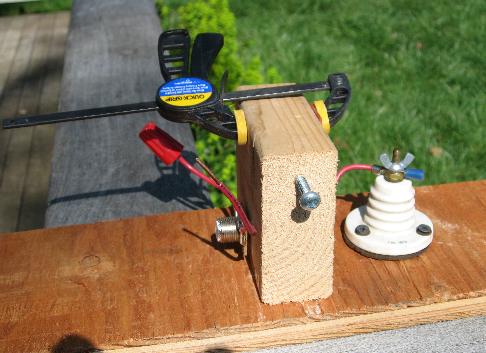Work that DXpedition on 160m
N8S (Swain’s island) is active now, and BS7H (Scarborough Reef) will be active shortly; in this part of the sunspot cycle, why not try to work them on 160m? If you have the time and room, a reasonable antenna might be like W7IUV’s Vertical, but if you need them on 160 NOW, here’s a quick and fairly easy antenna to use, DXpedition style, to try to work these operations. You can build a balloon-supported ground plane for 160m.
One like this was used in the Washington Salmon Run by W7DX to work 55 stations in one hour (September 2006).
We build a ‘fancy’ version of this feedpoint to use over and over again:

FIRST SOME SAFETY: Don’t use this NEAR any overhead electrical lines, or anywhere where it could break free and become tangled in any electrical lines; Don’t do this near an airport. Don’t do this where you could cause a big distraction (e.g. near a busy road or highway). Don’t do this where you could in any way cause injury or damage. Use all of these instructions at your own risk.
You’ll need:
- permanent marker to mark your fishing line
- 8 or 10 lb monofilament fishing line (get it from the sporting goods store)
- A brick or something to hold down your balloon
- 1 SO-239 connector (you can get by without it if you want to be ultra temporary)
- Short piece of #12 wire soldered to the center pin of the so-239, two others soldered to the body of the so-239 to attach radials
- Wire nut (red one) for the #12 wire
- 134′ of 30 gauge magnet wire (“315 ft Magnet wire set” from Radio Shack- 278-1345)
- Two or three helium filled mylar balloons from the grocery store or party supply store (try to find the most volume for the smallest price)
- at least 270 more feet of wire to use as radials
- Sandpaper to scrape insulation from your magnet wire
- (optional) 150k resistor (1/4 or 1/2 watt) soldered between the SO-239 center pin and shield
- Some basic tools
Measure out 136′ of fishing line — you’re going to use up 6″ tying to the mylar balloons, and 6″ tying to something on the ground. Mark the fishing line at 135′
Lay out your ground system — if you can operate near an area of good ground conductivity, or near the shore of big body of water (hopefully in the direction of the DX), all the better. If you can put out four to six radials that are 135′ long or so, do it. If you can’t, but you can get the feedpoint into the air 20′, try two or three radials. If your lot is only 50′ x 50′ and you have 1000′ of wire, you are probably in the city and shouldn’t be flying the balloon near power lines anyway. Attach the radials to the 12 gauge wires you soldered to the BODY of the SO-239.
In calm Winds, with no chance or forecast for thunderstorms or lightning, put your feedpoint in the center of the radial system, and attach balloons to your monofilament. Attach the 30gauge wire to your balloons, as well. Slowly let both wife and monofilament out until the balloons are 135′ in the air, per your marking on the monofilament. Tie the monofilament to the brick or other hold down device. Snip the magnet wire, strip the insulation with sandpaper, and wire-nut it to the center of the SO-239. Using your rig at LOW POWER, check to make sure your SWR is below 2:1. You’re ready to go. You will notice that the SWR will change as the balloon ‘heels over’ in wind.
Your next challenge will be to HEAR the DX; if you’re trying this vertical in a rural area, you have a chance of doing so on the vertical. If you have a lot of noise, you might need to use a K9AY or other type of loop to get some directionality, or use a beverage type antenna to minimize high-angle reception.
Note that this antenna has the potential (pun!) to gather static, just by being in the air. Put a 150K resistor on the SO-239 to drain static to ground, and make sure that the SO-239 body is attached to ground. If you’re using and elevated feedpoint and elevated radials, be careful of static that might build up as you attach your coax to the feedpoint — you could get a static electricity shock.